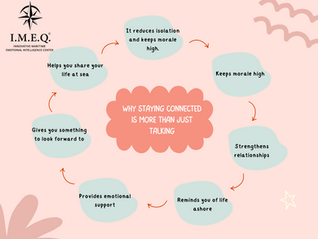Post-Traumatic Stress Disorder and Acute Stress Disorder
- IMEQ CENTER

- Jan 12, 2017
- 5 min read
Updated: May 31, 2021

Trauma and stressor related – disorders are disorders that develop after exposure to traumatic events. There is a close relationship between trauma and stressor – related disorders and anxiety disorders in that the causes are often the same but the manifestations differ in nature. The main difference between these types of disorder, which is also the general symptomatology for all trauma and stressor – related disorders, is that the reaction to the traumatic or stressful event is based in dysphoria, anhedonia, aggression or dissociation.
Seafarers are an at – risk population for developing trauma and stressor – related disorders, particularly Post – Traumatic Stress Disorder (PTSD) and Acute Stress Disorder (ASD). The maritime environment is not without dangers and traumatizing events can occur on board, particularly through accidents and piracy, with piracy being the leading cause for trauma and stress – related disorders in seafarers, particularly those who have been held hostage by pirates.
More than 3000 seafarers have been held hostage by Somali pirates since 2001 and many more have been kidnapped from all around the world while some are still held in captivity. Seafarers who get kidnapped by pirates experience several forms of abuse, including being threatened with death, malnourished, beaten or threatened with beatings, isolation, torture and poor living conditions. While everyone who experiences traumatic events is affected afterwards, this isn’t always the case. Studies show that the majority of seafarers who had been held hostage do not have any lasting impairments in their mental health but approximately 25% of them show signs of PTSD – related symptoms. Seafarers who experience traumatic symptoms can often decline contracts due to fears of piracy, which can lead to a sizeable reduction in the workforce.
Below we will examine the symptoms of Post – Traumatic Stress Disorder (PTSD) and Acute Stress Disorder (ASD).
Post – Traumatic Stress Disorder
To be diagnosed with PTSD, an individual needs to have witnessed, directly experienced in full or to have been exposed to aspects of a traumatic event, such as actual or threatened death, violence or sexual abuse. Learning of traumatic events that occurs to a loved one is also a cause for PTSD. After the experience of the traumatic event one or more of the following symptoms needs to occur.
Recurrent, intrusive and involuntary memories pf the traumatic events that cause distress.
Recurrent dreams that recreate or relate to the traumatic events and cause distress.
Dissociative reactions in which the individual is loses awareness, partially or fully, and relives the traumatic experience, commonly referred to as a “flashback”.
Intense and / or prolonged distress when the individual is exposed to anything that may resemble or be associated with the traumatic event.
Noticeable physiological reactions to anything that may resemble or be associated with the traumatic event such as being startled.
Individuals suffering from PTSD often go to great lengths to avoid and memories, thoughts and feelings that are associated with the traumatic events and tend to avoid the people, places and situations that trigger these memories, thoughts and feelings.
PTSD also has effects on both mood and cognitive function. Individuals suffering from the disorder are often unable to remember parts of the traumatic event, they can have persistent and overly negative beliefs or expectation of themselves and others and skewered perceptions of the world. They can feel responsible for the event that happened to them or blame others that were not at fault due to distorted thoughts regarding the event and constantly experience negative feelings such as anger, guilt or shame. Lack of interest in activities that used to be important and feeling detached from other people can be observed, as well as an inability to experience positive emotions.
Individuals suffering from PTSD can be irritable and have verbal or violent angry outbursts, often without or with very little provocation, can engage in unsafe and reckless behavior, be in a constant state of vigilance, be easily startled and have issues sleeping and concentrating. PTSD can present with depersonalization, which is defined as feeling detached from your mind or body as if you were an outsider and derealization, which is defined as persistent or recurring feelings of the world around you not being real. It is noteworthy that, in some cases, the symptoms can present several months after the traumatic event, therefore, if the individual doesn’t show signs of PTSD following a traumatic event it may still present later so monitoring is needed.
Acute Stress Disorder
The symptomatology of ASD is exactly the same as in PTSD with one key difference. ASD onsets within the first month following a traumatic event and resolves itself within the same month while PTSD’s onset can be months after the event and it tends to be chronic. People suffering from ASD go through the same symptoms and show the same behaviors but the disorder naturally goes into remission within the first month. If it persists, the diagnosis then changes to PTSD.
When looking at Post – Traumatic Stress Disorder and Acute Stress Disorder, it is important to understand that not all the symptoms mentioned above need to be present to diagnose someone with an anxiety disorder. When examining the symptoms, the focus shouldn’t be one – sided but on deviations from the norm. So, if you suspect that you or someone close to you may suffer from PTSD or ASD, don’t look at the individual behaviors but, instead, look at what has changed.
Before assuming that an individual suffers from PTSD or ASD, it has to be taken into account that the only difference is the time period. If the symptoms are observed within one month following the traumatic event then it could be ASD, if it is longer then it could be PTSD. Additionally, it is crucial to turn to a licensed mental health professional if you suspect you or one of your loved ones has PTSD symptoms. Since ASD can progress to PTSD if left untreated, prevention is crucial.

Treatment
PTSD and ASD are treated through therapy and medication. Pharmaceutical therapies for panic attacks focus on symptom relief and treating comorbid anxiety and depression that can present with PTSD. Medications include antidepressants like Zoloft and Paxil, which can alleviate both depressive symptoms and help improve sleep and concentration, anxiolytic medications which are used, usually short – term, to handle anxiety symptoms and a drug called Prazosin. Although not an official medication for PTSD treatment, Prazosin can help reduce or suppress nightmares in people suffering from PTSD.
There are therapeutic interventions that are effective in treating PTSD. Cognitive Therapy, which helps the individuals recognize defective cognitive patterns that keep them stuck on negative beliefs and fears of the event reoccurring. Exposure Therapy helps individuals face the situations and memories that elicit the symptoms in a safe environment and teaches them to cope with them. Exposure therapy is particularly helpful with flashbacks and nightmares. Finally, there is Eye Movement Desensitization and Reprocessing (EMDR). EMDR is a combination of exposure therapy with eye movements in which the therapist will ask the individual to recall the event while performing eye movement exercises and slowly shift the thoughts that arise from the recollection to more pleasant thoughts.
For ASD, medication can be used for a short time to alleviate the symptoms and, to prevent the progression to PTSD, the use of Cognitive Behavioral Therapy that combines exposure and cognitive restructuring seems to be the most effective while the practice of Mindfulness can reduce the associated stress.
Helping Seafarers
The steps that can be taken to ensure the wellbeing of seafarers dealing with PTSD is to provide mental health support and take steps to protect seafarers from piracy. The maritime industry’s greatest asset are the workers and providing support can benefit the companies financially and legally. Social integration following the kidnapping is also important for every victim of piracy, not only those who present PTSD symptoms.





































































































Comments